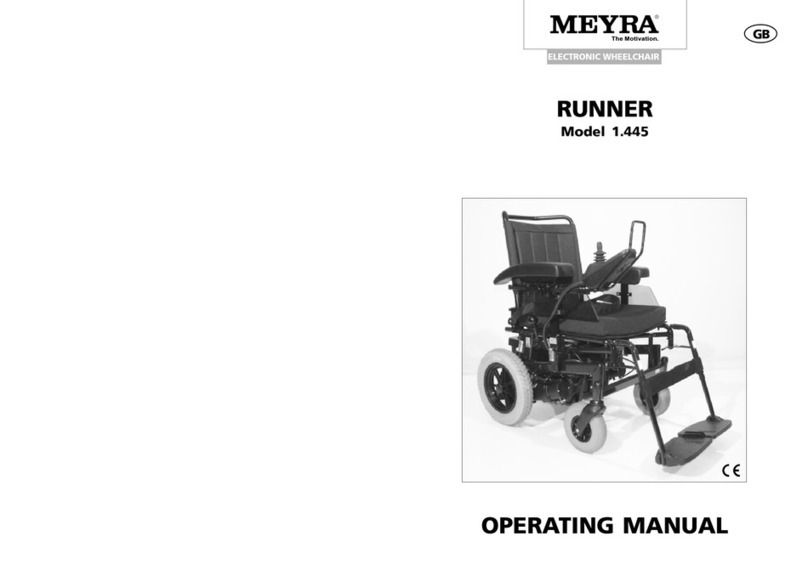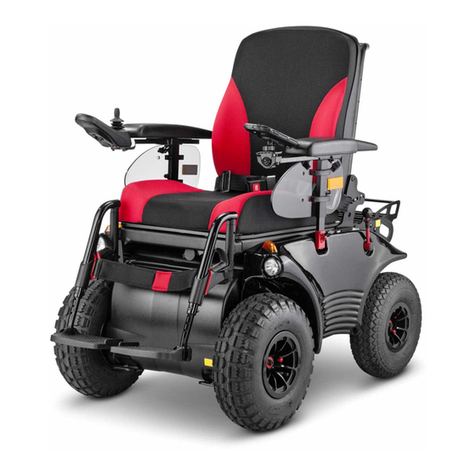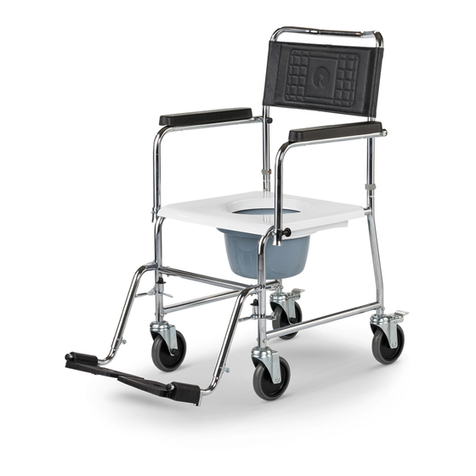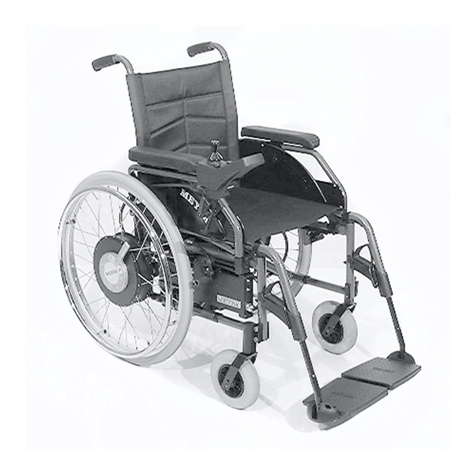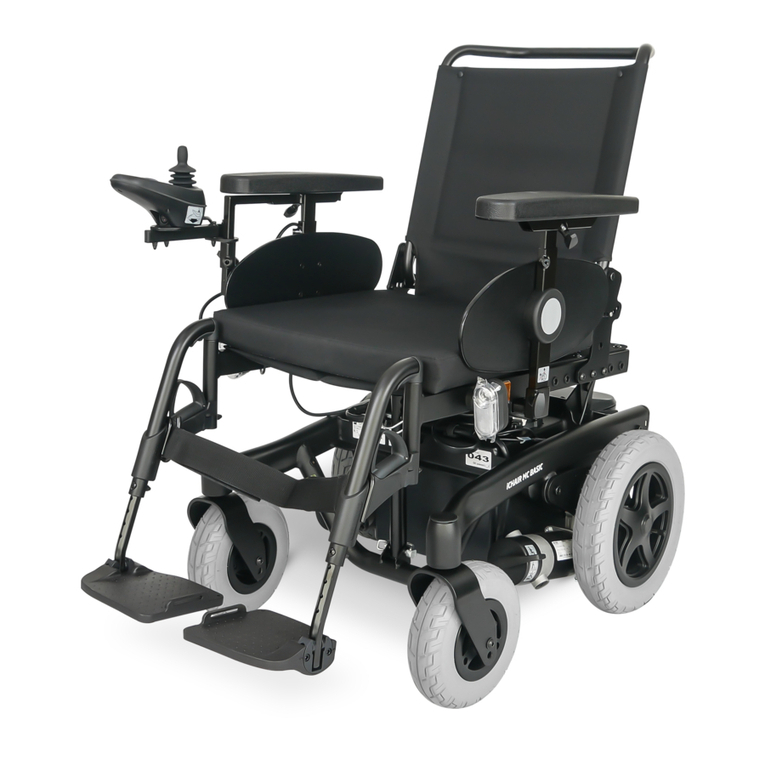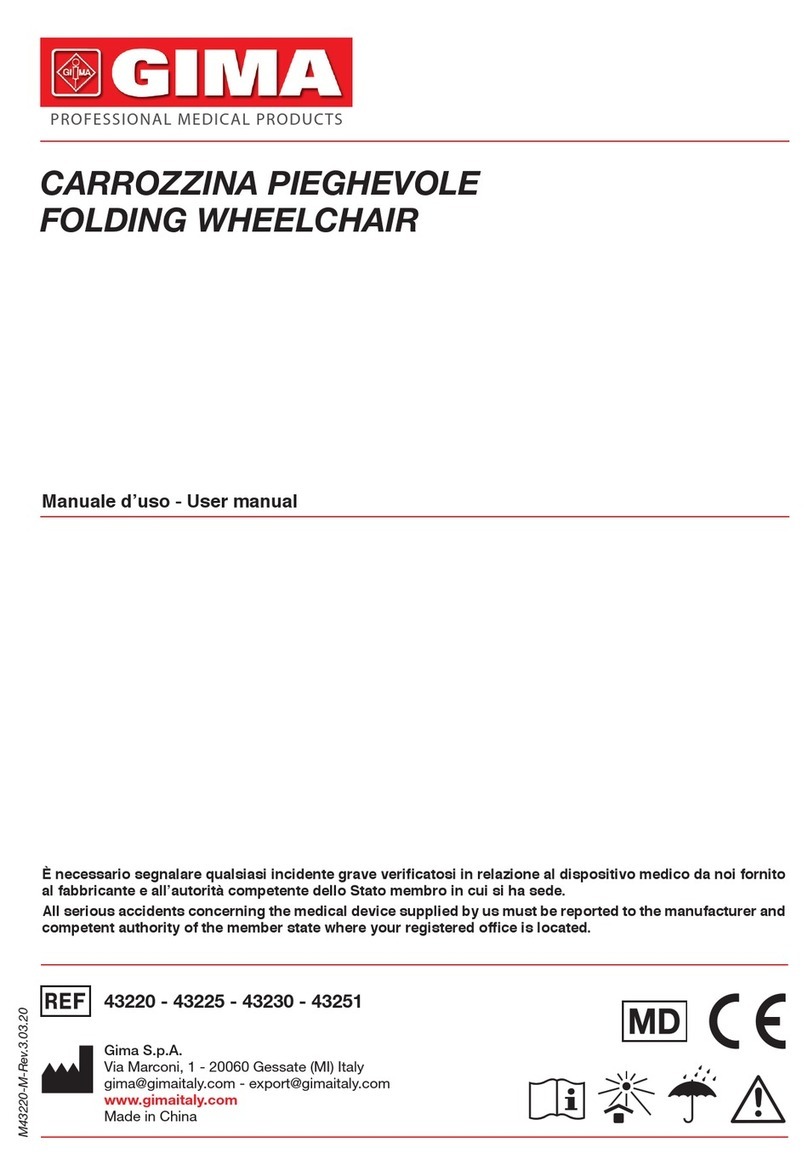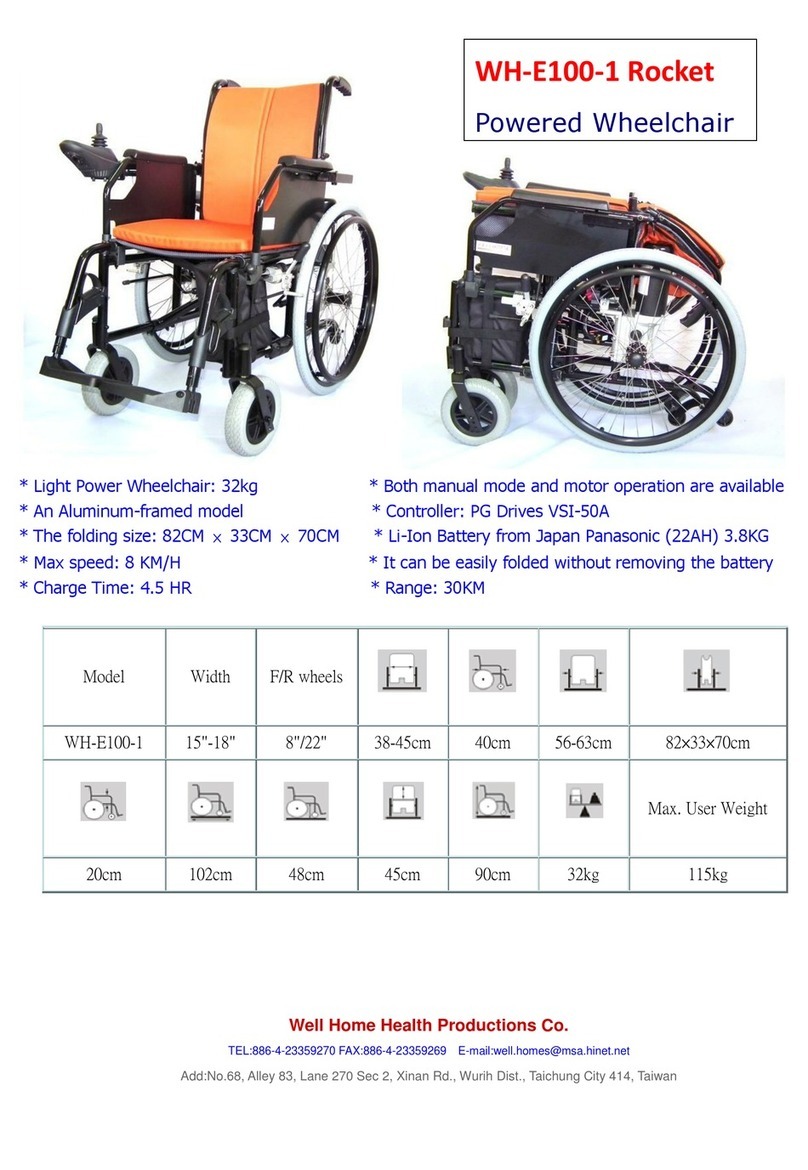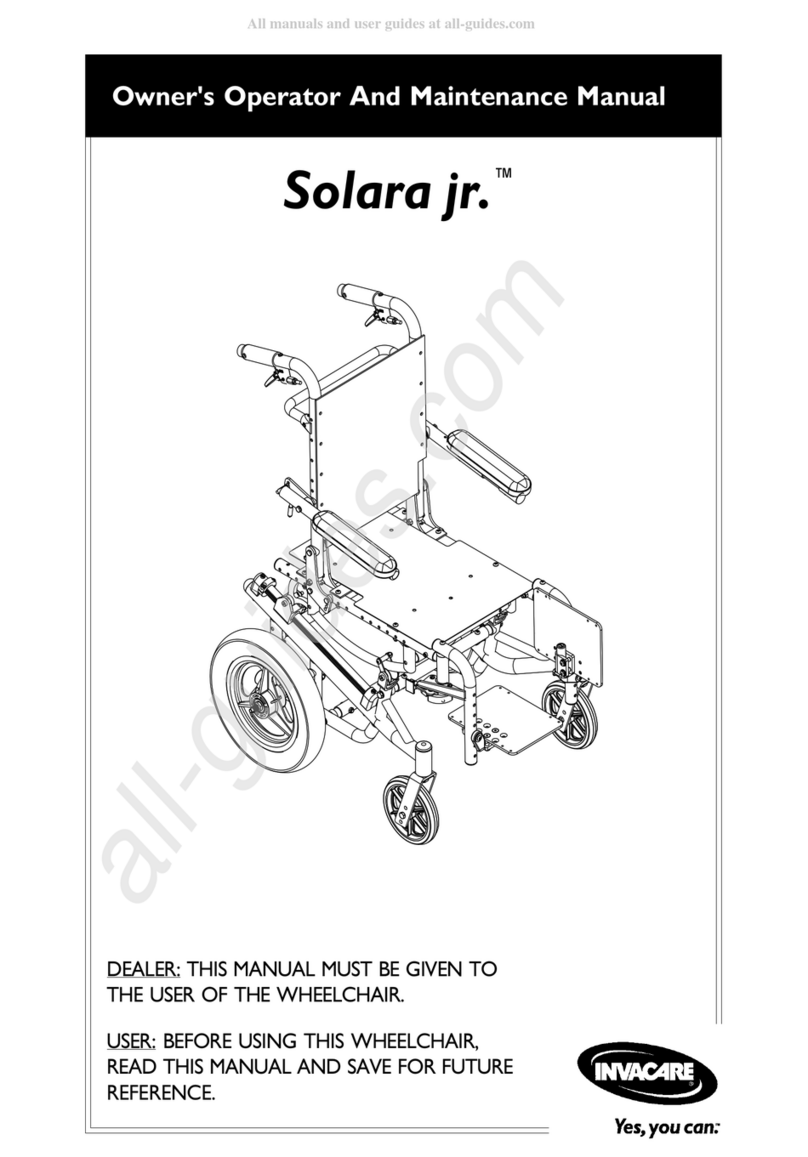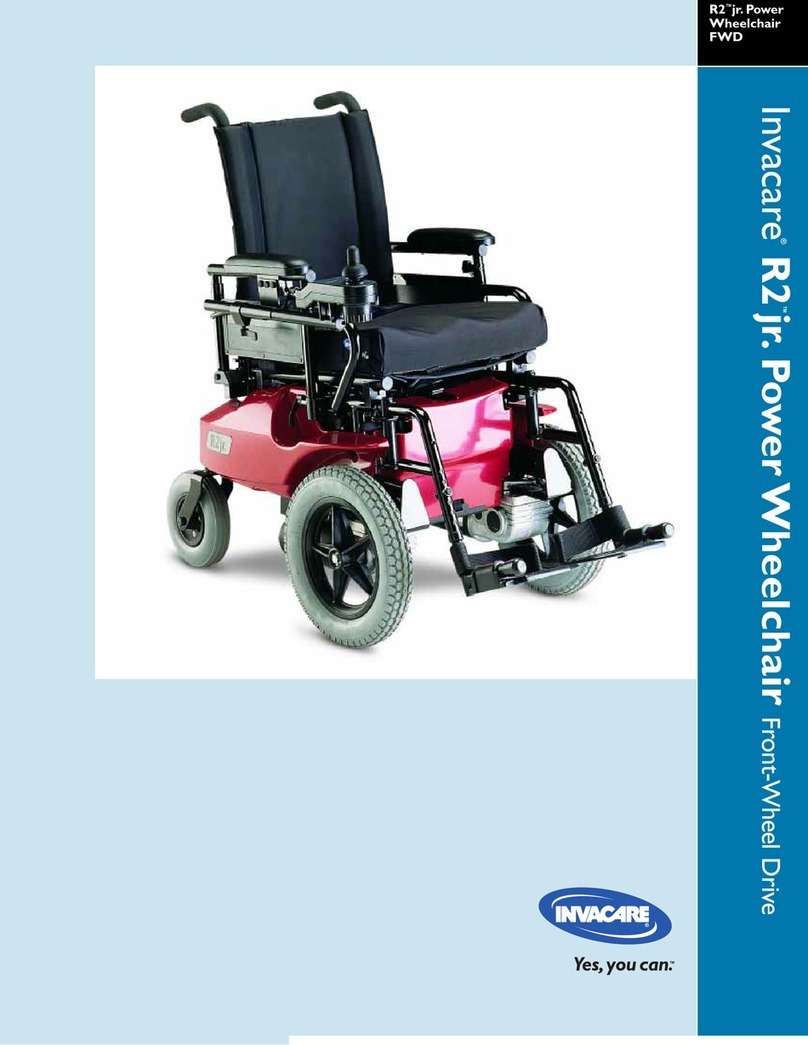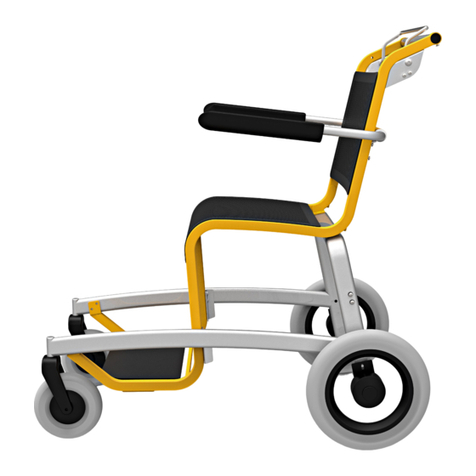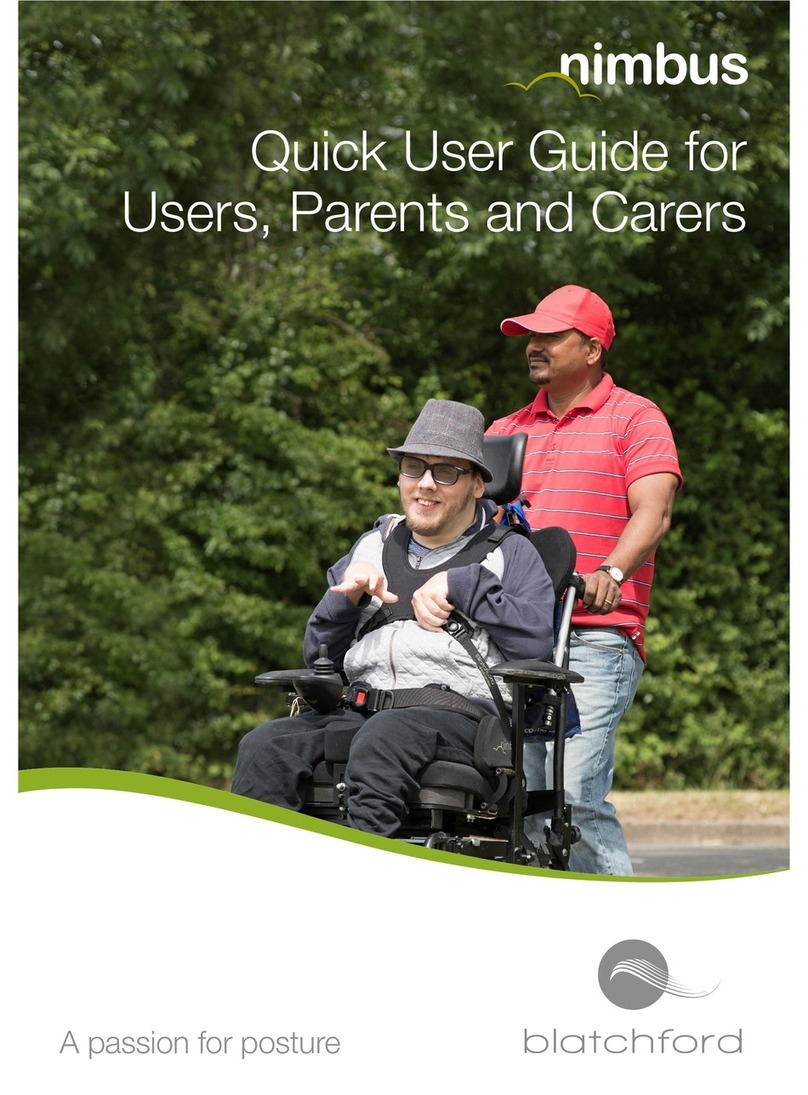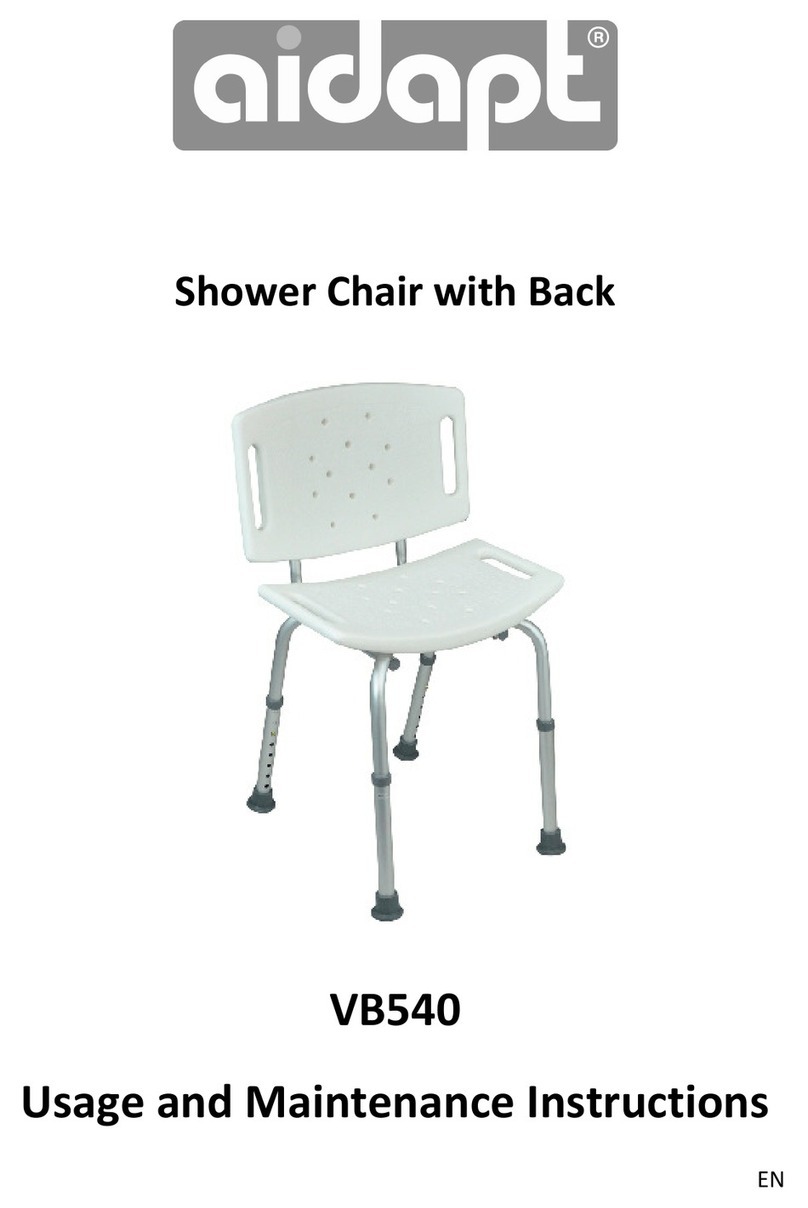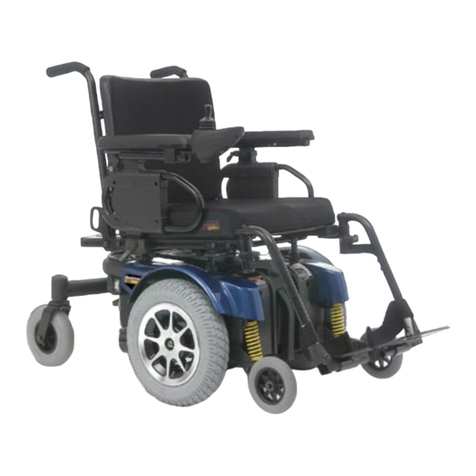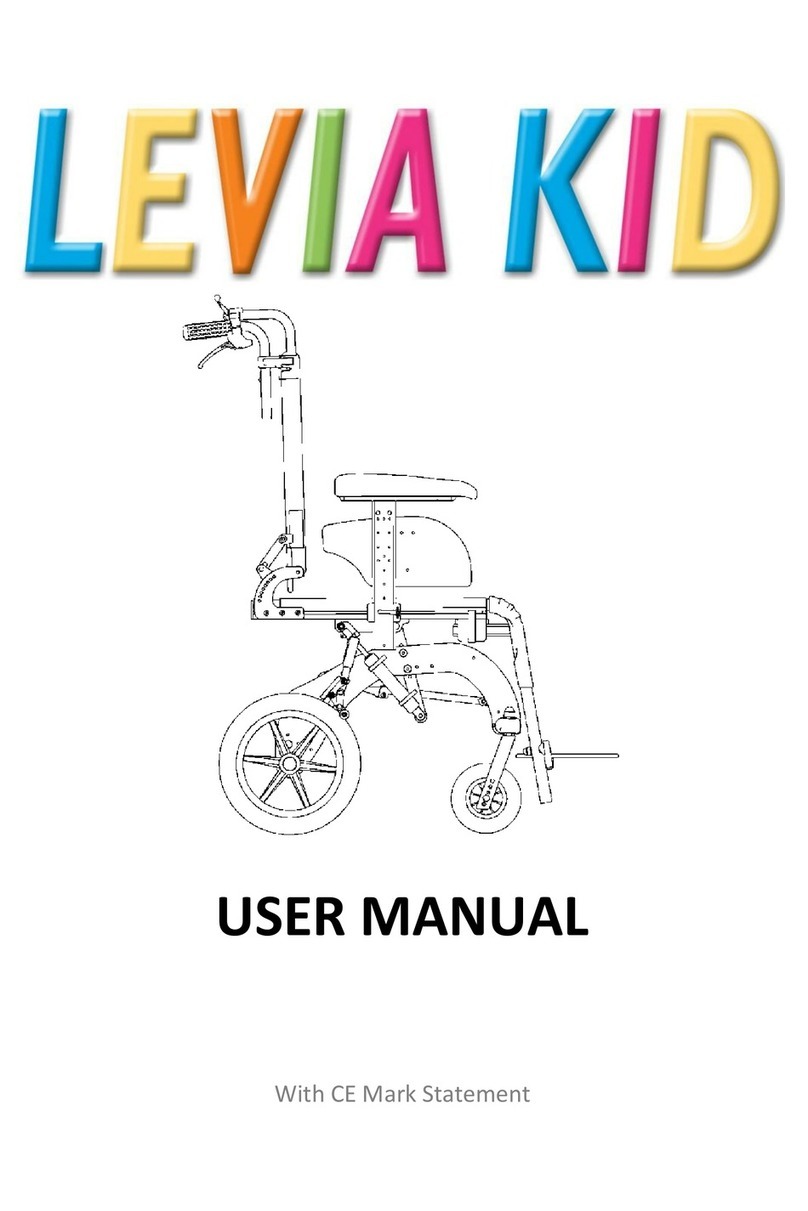Meyra Eurochair2 2.750 User manual

en
Operating manual
Lightweight wheelchairs
Model 1.750, 1.850 Eurochair
Model 2.750 Eurochair2
Model 2.850 Eurochair2Pro, XXL

2

3
Contents
Meaning of the applied markers 7
Introduction 7
List of models 7
Indications / contraindications 7
Acceptance 8
Intended purpose 8
Use 8
Wheelchair folding/unfolding/carrying 9
Adjustment 9
Combination with manufacturer foreign products 10
Reinstallment 10
Life span 10
Overview 11
Brake 12
Pressure brake - user 12
Locking the brakes 12
Releasing the brakes 12
Service brake 12
Drum brake for accompanying persons 13
Function as operating brakes 13
Brake lever extension 14
One-hand brake 14
Particularity of the one hand brake 14
Leg supports 15
Calf belt 15
Removing the calf belt 15
Attaching the calf belt 15
Length adjustment of the calf belt 15
Heel strap 16
Removing the heel strap 16
Attaching the heel strap 16
Length adjustment of the heel strap 16

4
Lower leg support 17
Footplates 17
Footboard 17
Leg support upper part 18
Turning the leg supports to the side 18
Swivelling in the leg supports 19
Removing the leg supports 20
Attaching the leg supports 20
Mechanically height-adjustable leg supports 21
Lifting/lowering the leg support 21
Lifting/lowering the amputee leg support 21
Arm supports 22
Removing the arm support 23
Inserting the arm support 23
Swivelling up the arm support 24
Height adjustment of the arm support 25
Back support 26
Back support belt, standard 26
Back support with angle adjustment 26
Stepwise adjustable back support 26
Continuous angle adjustment of the back support 27
Back shell 28
Removing the back support shell 28
Assembly of the back support shell 28
Push bar 29
Push handles 30
Wheels 31
Drive wheels 31
Manoeuvre rollers 31
Support castors 32
Support castor length 32
Stick-in support castors 32
Removing/inserting the support castors 32
Swivelaway support castors 32
Swinging the support castors 32

5
Handrims 33
Specialities for double handrims 33
Propelling the wheelchair 33
Folding/unfolding with double handrims 33
Head support 34
Therapy table 34
Retaining strap 35
Basic safety information 36
Accompanying person 36
Transfer out of the wheelchair 37
Reaching for objects 37
Driving on falling, rising or transverse gradients 37
Crossing obstacles 38
Loading the wheelchair 38
Transport in vehicles 39
Transport safety of the empty wheelchair 39
Transport of people inside a motor vehicle 39
Transport in public methods of transportation 39
Driving on public highways 40
Cleaning 40
Finish 41
Disinfection 41
Repairs 41
Repairs 41
Customer Service 41
Spare parts 41
Information for extended pauses of use 42
Disposal 42
Maintenance 42
Maintenance 42
Maintenance schedule 43

6
Technical data 45
Tyre pressure of pneumatic tyres 45
Applied norms 45
Data according to ISO for model 1.750 Eurochair 46
Further technical data for model 1.750 Eurochair 47
Data according to ISO for model 1.850 Eurochair 48
Further technical data for model 1.850 Eurochair 49
Values acc. to ISO for model 2.750 Eurochair250
Further technical data for model 2.750 Eurochair251
Values acc. to ISO for model 2.850 Eurochair2Pro 52
Further technical data for model 2.850 Eurochair2Pro 53
Values acc. to ISO for model 2.850 Eurochair2XXL 54
Further technical data for model 2.850 Eurochair2XXL 55
Meaning of the symbols on the washing instruction 56
Meaning of the labels on the wheelchair 57
Meaning of the symbols on the type plate 58
Inspection certificate 59
Warranty / Guarantee 60
Warrantee / Guarantee section 61
Inspection certificate for transfer 61
Notes 62

7
MEANING OF THE AP-
PLIED MARKERS
Safety instructions with a coloured back-
ground are mandatory and need to be
observed under any circumstance!
☞This symbol indicates tips and recom-
mendations.
[ ] Reference to a picture number.
( ) Reference to a function element within
a picture.
INTRODUCTION
Read and observe this manual before first
operation.
Children and juveniles should read this
documentation together with their par-
ents respectively a supervisor or accom-
panying person before first use.
Your specialist dealer should also intro-
duce you into the use of your wheelchair.
This operating manual is to help you get ac-
customed to the handling of the wheelchair
as well as to prevent accidents.
☞Please note that the illustrated equip-
ment variants can deviate from your
model.
We have therefore also listed chapters with
options that might not be applicable for
your vehicle. A list of the available options
and accessories can be viewed in the order
form of your wheelchair.
Users with visual impairments can find the
PDF-files together with further information
on our website:
< www.meyra.com >.
☞Contact your specialist dealer when re-
quired.
Alternatively users with visual impairments
can have the documentation read out by a
helper.
Inform yourself regularly about product
safety, possible recalls and general handling
instructions of our products in the < Infoz-
entrum > on our website:
< www.meyra.com >.
We have developed a product that fulfils
the technical and legal requirements of
medical devices. For information about a se-
vere accident that can still not be ruled out
completely, please use our E-mail address
sible governmental agency of your country.
LIST OF MODELS
This operating manual applies to the follow-
ing models:
Model 1.750, 1.850
Model 2.750, 2.850
INDICATIONS /
CONTRAINDICATIONS
In case of allergic reactions, skin rashes
and/or pressure sores during the use of
the wheelchair sores contact a doctor im-
mediately.
In order to prevent contact allergies, we
recommend to use the wheelchair only
when wearing clothes.
Upon others, the wheelchair serves for
support in case of extremely pronounced
walking disability resp. the inability to walk,
e. g. paralysis, defect or deformation of the
extremities, loss of extremities, damages
or contractures of joints, other diseases.
(Extreme to fully pronounced limitations
in mobility/walking with structural and/or
functional damages of the lower extremi-
ties (u.o. amputation, after-effects of injuries,

8
musculoskeletal/neuromusculoskeletally
caused motion limitations etc.).
The wheelchair may not be used without
an accompanying person in cases of imbal-
ance, cognition disorders, large extremity
loss on both arms, contractures / damages
of joints of both arms, insufficient or no eye-
sight or the disability to sit.
☞Please ask your doctor, therapist or
specialist dealer to these and possi-
ble other risks in combination with
this product.
ACCEPTANCE
All products are checked for faults in the
factory and packed in special boxes.
☞However, we request that you check
the vehicle for possible transport dam-
age immediately on receipt – prefera-
bly in the presence of the carrier.
☞The packaging of the wheelchair
should be stored for a further transport
that might become necessary.
INTENDED PURPOSE
The wheelchair family serves for independ-
ent movement of one person or transport
through an accompanying person.
The wheelchair was developed for adults
and adolescents.
USE
In case of physical limitation, such as
blindness, a driving ability certifications
for independent driving of the wheelchair
is required.
Do not reach into the spokes or grip the
tyres of the rotating wheels. – Danger of
injury!
Do not reach into the space between the
pressure brake and the tyre when propel-
ling the wheelchair. – Danger of injury!
Avoid a jerky propulsion of your wheel-
chair. – Danger of tipping over or tilting!
Do not use the wheelchair without at-
tached leg supports and arm support
units!
In certain configurations your wheelchair
might exceed the maximum dimensions
of emergency routes. Always make sure
whether possible escape routes are wide
enough for your wheelchair.
The wheelchair is applicable on level, firm
surfaces and can be used as follows:
– for indoors (e.g. apartment, day care),
– outdoors (e.g. paved paths in parks),
– as a companion on tours (e.g. in a bus
or train),
☞In specific dimensions (overall
height, overall width, overall length,
turning radius) your wheelchair is
not suited for transport within a
train.
☞Get information on possible limita-
tions before the transport.
– transport within an airplane should
only be done with PU-tyres.
☞Ask the airline for possible limita-
tions before transport in an airplane.
– Never expose the wheelchair to ex-
treme temperatures and damaging

9
environmental conditions, such as sun-
light, extreme cold or salty water.
– Sand and other dirt particles can seize
on moving parts and render them with-
out function.
– Use only the handrims on the drive
wheels to propel your wheelchair.
You must not let yourself be carried in your
wheelchair by having the wheelchair lifted
from the floor. Parts that are not securely
fixed, e.g. side elements or leg supports, can
come away and thus cause an accident.
☞The wheelchair is a vehicle and not a
carrying device.
Only apply the wheelchair within the
scope of the specifications and limitation
described in chapter Technical data on
page 45.
WHEELCHAIR FOLDING/
UNFOLDING/CARRYING
You wheelchair can be folded without the
aid of tools.
1. Remove the seat cushion, if applicable.
2. Lift up the footplates or remove the leg
supports.
3. Pull the seat belt upward in the centre
of the front and back.
4. If necessary remove the connection
rod of the double handrim drive or the
push bar.
Your wheelchair can be carried without dif-
ficulty when folded.
For this, push one lower arm from the front
under the upward folded seat belt. Place
other hand underneath the rear seat fold for
support.
Lift the wheelchair to horizontal position.
Tip the wheelchair slightly to one side in
order to make the unfolding easier. At the
side resting on the floor, press the seat tube
down to the end stop.
☞You may need to press down both seat
tubes with the hands in order to do this.
☞Ensure that the seat tube sits securely
on the support surface.
ADJUSTMENT
Always have adaptation, adjustment or re-
pair work carried out by a specialist dealer.
The wheelchair offers manifold adjustment
possibilities to individual vital statistics. Be-
fore first use an adaptation of the wheel-
chair and a practical instruction in the
functionalities of your wheelchair should
be carried out by your specialist dealer. The
adaptation will take into account the driving
experience, the physical limits of the user
and the main place of use of the wheelchair.
Before first use, check the functionality of
your wheelchair.
☞We recommend a regular control if
the wheelchair adjustment in order to
ensure a long-term optimal provision
even with changing illness/handicap
patterns of the user. Especially for juve-
niles an adjustment every 6 months is
recommendable.

10
COMBINATION WITH MAN-
UFACTURER FOREIGN
PRODUCTS
Any combination of your wheelchair with
components not supplied by us generally
results in an amendment to your wheel-
chair. Please inquire with us if there is a valid
combination clearance/release.
Auxiliary drives
Mounting of additional- and front attach-
ment drives constitute an extreme amend-
ment of the wheelchair. The amendment
will result in a forfeiture of the declaration of
conformity for the wheelchair.
☞The verification of conformity in combi-
nation with the valid medical device di-
rective / medical device ordinance lies
in the responsibility of the supplier of
the additional or header drive. He is also
responsible for the product included
documentation of the medical product
combination.
REINSTALLMENT
The wheelchair is suited for reinstallment.
With the building block system the wheel-
chair can be fit to accommodate different
handicaps body sizes. Before reimplemen-
tation the wheelchair is to undergo a com-
plete inspection.
☞Hygienical measures required for rein-
stallment are to be carried out accord-
ing to a validated hygienic plan and
must include disinfection.
The service manual, intended for the spe-
cialist dealer provides information to the re-
installment and reinstallment frequency of
your wheelchair.
LIFE SPAN
We expect an average life span of about
4 years for this wheelchair, as far as the
wheelchair is applied for its designated
purpose and all maintenance and service
guidelines. The life span of your wheelchair
depends upon the frequency of use, the ap-
plication environment and care. The imple-
mentation of spare parts can prolong the
life span of the wheelchair. As a rule spare
parts are available up to 5 years after pro-
duction is discontinued.
☞The indicated lifespan does not consti-
tute additional guarantee.

12
11
13
10 8 7
6
5
4321
9
11
Pos. Description
(1) Push handle
(2) Back support
(3) Arm support
(4) Arm support / clothes guard
(5) Seat belt/seat cushion
(6) Locking lever – Leg support
(7) Footboard/footplates divided
OVERVIEW
The overview shows, representative for all models, the most important components of the
wheelchair.
(8) Steering wheel
(9) Type plate (on the crossbrace)
(10) Driving wheel
(11) Handrim
(12) Locking knob – Quick release axle
(13) Brake lever – pressure brake

3
1
1
2
4
12
BRAKE
Arrange an immediate repair of the brakes
by your specialist workshop if the braking
performance reduces.
Wheelchairs with PU-tyres when stored
for longer periods of time, should be put
away safely without activated pressure
brakes, since otherwise permanent defor-
mations to the tyre surface could occur.
By locking the brakes with the brake lever
(1), the wheelchair is secured against rolling
away unintentionally (parking brake).
Depending on the version, the wheelchair
can be equipped with pressure brakes (2) or
with drum brakes (3).
Pressure brake - user
Locking the brakes
To secure the wheelchair against any unin-
tentional rolling, press both brake levers for-
ward all the way [4].
☞It should not be possible to push the
wheelchair forward when both brakes
are locked.
Releasing the brakes
Pull both brake levers back all the way [2].
Service brake
The wheelchair is braked down with help of
the handrims.
☞If needed use suitable gloves in order to
brake down the wheelchair.

1
C
A
B
2
13
Drum brake for accompanying
persons
The drum brake is activated by the accom-
panying person through the brake levers [1].
Function as operating brakes
Use both brake levers evenly and only light-
ly in order to achieve a controlled decelera-
tion of the wheelchair.
Locking the drum brakes
Pull both brake levers [1] and press the lock-
ing latch (2) forward.
Release the brake lever. – Depending on the
adjustment the latch engages in the first (A)
or second (B) locking position and activates
the brake.
☞If the third locking position (C) is re-
quired to activate the brake, it must be
readjusted by a specialist workshop.
Loosen the drum brakes
Pull both brake levers (1) until the latches
(2) automatically jump out of the locking
points.
Let go of both brake levers. – The parking
brakes are released and the wheelchair
ready for use.

1
2
3
14
Brake lever extension
Do not use the grips of the brake lever as
support.
Do not pull off the brake lever extension
whilst in motion. – Accidents could result
if the brake lever extension is drawn too
much.
The brake lever extensions multiply the ap-
plied brake force and reduce the force you
need to apply in order to lock the brakes (1).
☞For transfer into/out of the wheelchair
pull the brake lever extension off of the
brake levers.
☞Only use the wheelchair with the brake
lever extensions attached.
One-hand brake
The one hand brake [2] enables a locking of
the brakes with only one brake lever.
Particularity of the one hand brake
The brake lever of the one hand brake can
be swivelled backward after it has been
pulled upward [3].

2
1
15
LEG SUPPORTS
Before any actions on the leg supports
the wheelchair is to be secured against
unintentional rolling motions.
☞Therefore observe chapter Brake on
page 12.
Calf belt
Do not drive without the calf belt. – Dan-
ger of accidents.
The removable calf belt (1) prevents the feet
from sliding off the back of the footboard.
☞The calf belt must be removed in order
to swivel away the leg supports.
☞The calf belt is omitted for height ad-
justable leg supports and is replaced by
a calf pad.
Removing the calf belt
For removal the calf belt is to be pulled from
the attachment pins (2).
Attaching the calf belt
For attachment both loops of the calf belt
are slid over the attachment pins (2).
Length adjustment of the calf belt
For length adjustment, the calf belt is guid-
ed around the special attachment pins (2)
and adjusted in length with a velcro fasten-
er.

1
2
3
16
Heel strap
The heel strap (1) prevents the feet from
sliding off the back of the footplates.
Removing the heel strap
For removal the heel strap is pulled off of
the attachment bar (2) or, after opening the
velcro fastener, pulled from the insert tube
(3).
Attaching the heel strap
For attachment the loop of the heel strap is
slid over the attachment bar (2) or the heel
strap is guided around the insert tube (3)
and closed with the velcro fastener.
Length adjustment of the heel strap
For length adjustment the heel strap is ad-
justed in length with help of the velcro fas-
tener.

4
5
1
3
17
Lower leg support
The footplates, resp. footboard needs to be
folded up before entry or exit [1].
☞Check the locking points!
– Remove both feet from the footplates.
– Remove lower calf belt, if present.
☞Therefore observe chapter Calf belt
on page 15.
☞Before starting to drive the footplates
resp. footboard need to be folded back
down [3] and the calf belt attached.
Footplates
The footplates can be folded outward and
up [1] resp. inward and down [3].
Footboard
Fold the footboard [4] up before swivelling
away and removing the upper leg support.
Folding up the footboard
In order to fold up the footboard lift the
loose end of the footboard as far as possible
[5].
Folding the footboard down
In order to fold down the footboard, lower
the loose end of the footboard as far as pos-
sible down onto the footboard bracket [4].

2
2
1
18
Leg support upper part
The upper leg support with an inserted
lower leg support is termed leg support.
Turning the leg supports to the side
Leg supports turned to the side are re-
leased automatically and can easily come
off. Note this when handling (e.g. trans-
port).
For easy transfer out of/into the wheelchair
as well as driving closer to a closet, bed or
bathtub the leg supports can be swivelled
away toward the in-/outside [1].
☞Remove the calf belt, if applicable, be-
fore swivelling away the leg supports.
☞Therefore observe chapter Calf belt
on page 15.
Fold up the footplates resp. footboard in or-
der to swivel away the leg supports.
☞Therefore observe chapter Lower leg
support on page 17.
Afterwards pull or press the respective lock-
ing lever (2) backward and swivel the corre-
sponding leg support outward.

1
2
3
20
Removing the leg supports
With removed leg supports there is an in-
creased danger of tilting backwards.
For easy transfer into and out of the wheel-
chair as well as a reduced wheelchair length
(important for transport) the leg supports
can be removed [1].
☞Remove the calf belt before swivelling
away the leg supports.
☞Therefore observe chapter Calf belt
on page 15.
For removal first swivel the leg support side-
ways [2] and then remove them toward the
top [1].
☞Therefore observe chapter Turn-
ing the leg supports to the side on
page 18.
☞Watch for possible danger of jam-
ming!
Attaching the leg supports
For inserting press the leg supports, swiv-
elled to the side, parallel to the front frame
tube and lower it into place. – In doing so
the holding pin must slide into the frame
tube.
☞After attachment swivel the leg sup-
ports inward [3].
☞Therefore observe chapter Swivel-
ling in the leg supports on page 19.
This manual suits for next models
4
Table of contents
Other Meyra Wheelchair manuals

Meyra
Meyra EUROCHAIR 2 THE ORIGINAL 2.750 User manual
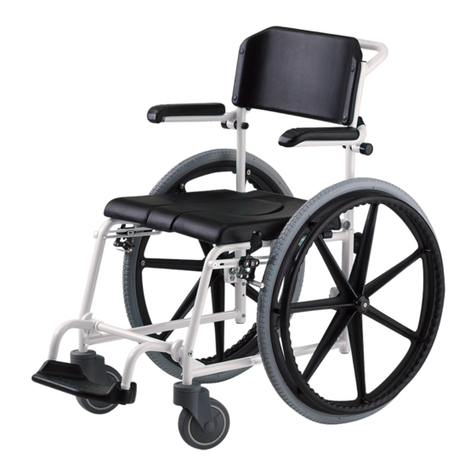
Meyra
Meyra 8013039 User manual
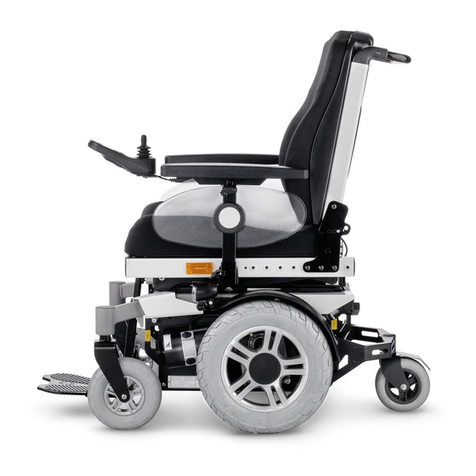
Meyra
Meyra 1.617 User manual

Meyra
Meyra 1.135 User manual
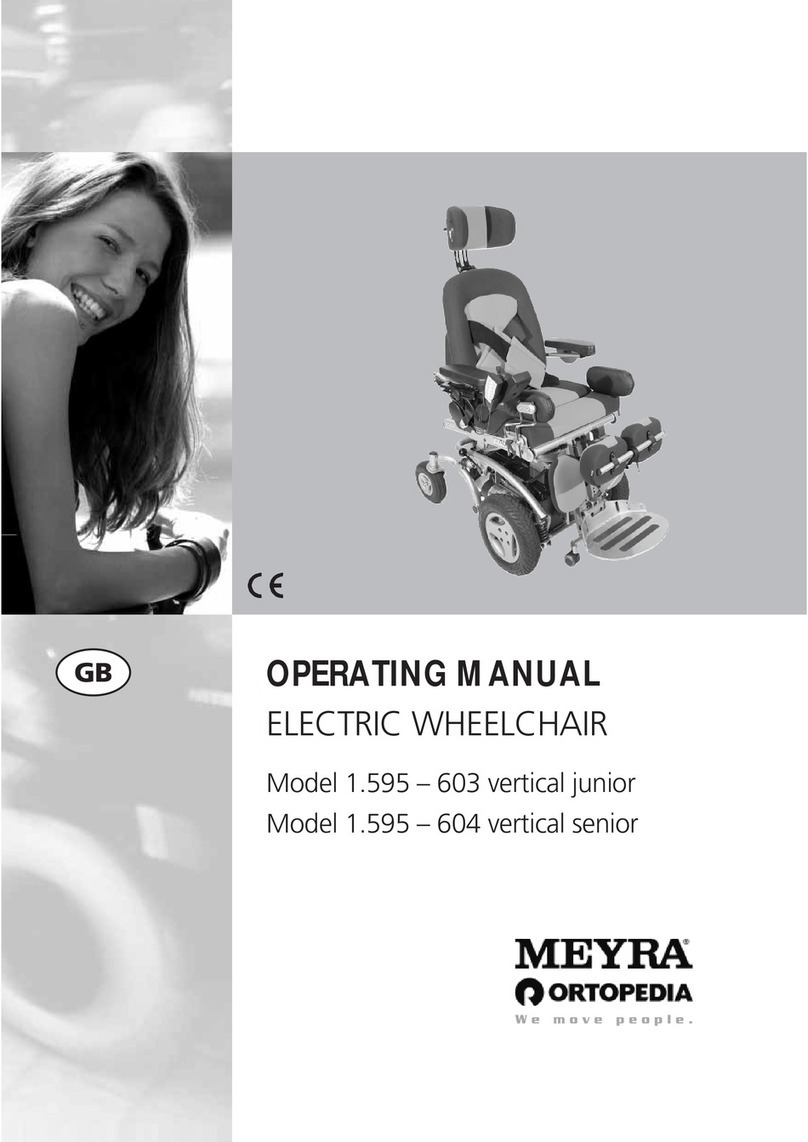
Meyra
Meyra 1.595-603 User manual

Meyra
Meyra 1.594 User manual

Meyra
Meyra MEX-X 1.130 User manual
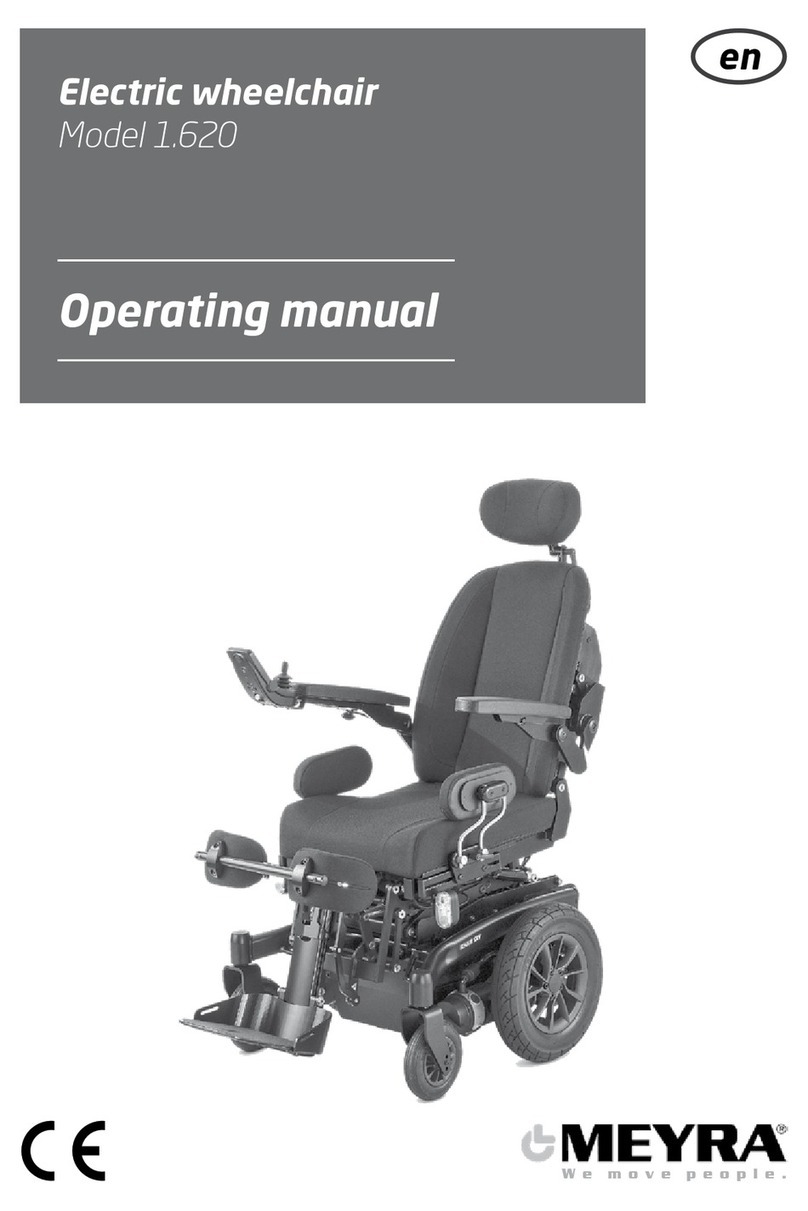
Meyra
Meyra 1.620 User manual

Meyra
Meyra 2.432 User manual
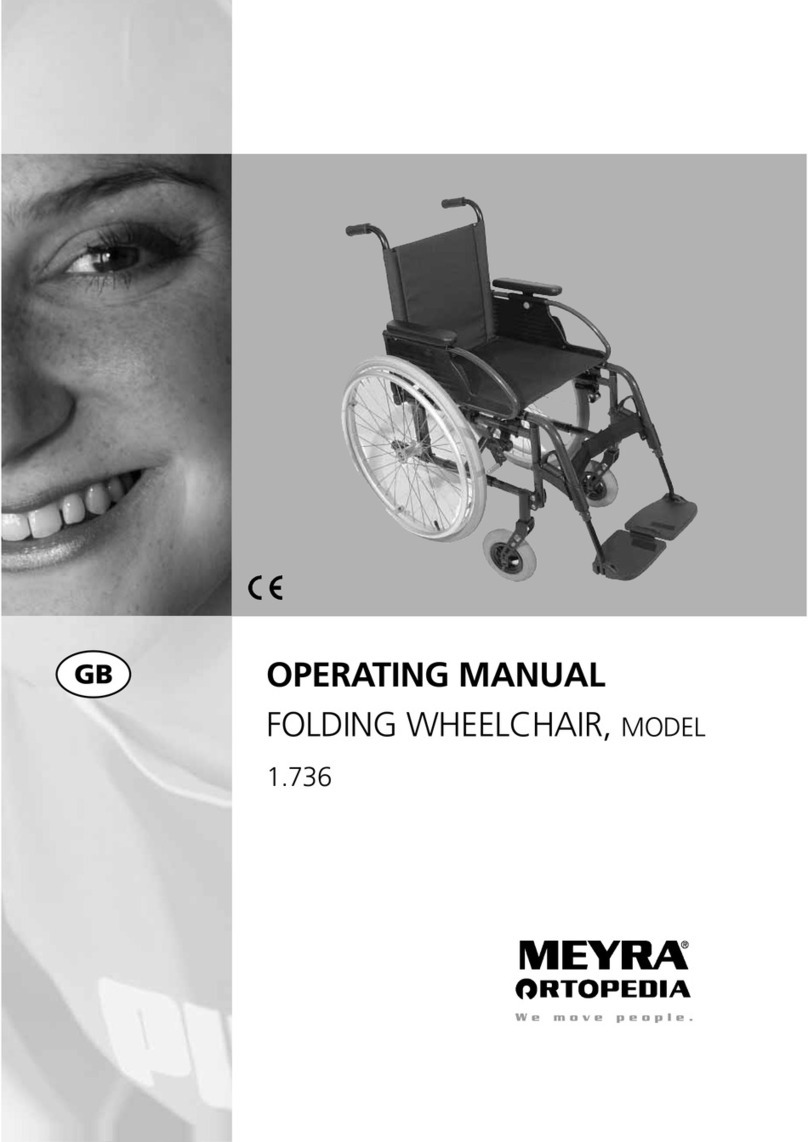
Meyra
Meyra 1.736 User manual

